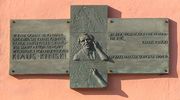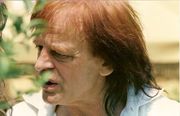Klaus Kinski
| Klaus Kinski | |
|---|---|
 Kinski in middle age |
|
| Born | Nikolaus Karl Günther Nakszyński 18 October 1926 Sopot, Free City of Danzig |
| Died | 23 November 1991 (aged 65) Lagunitas, California, U.S. |
| Occupation | Actor |
| Years active | 1948–1989 |
| Spouse | Gislinde Kühbeck (1952-1955) (divorced) 1 child Minhoi Geneviève Loanic (1971-1979) (divorced) 1 child Brigitte Ruth Tocki (1960-1971) (divorced) 1 child Debora Caprioglio (1987-1989) |
Nikolaus Karl Günther Nakszyński, best known as Klaus Kinski (18 October 1926 – 23 November 1991), was a German actor. He appeared in over 130 films, and is perhaps best-remembered for his collaborations with writer/director Werner Herzog.
Contents |
Life and work
Early life and background
Klaus Kinski was born in Sopot, in the Free City of Danzig. He was the son of a German father of Polish descent,[1] Bruno Nakszyński, a pharmacist and a failed opera singer, and a German mother Susanne (née Lutze), a nurse and a daughter of a local pastor.[2] He had three older siblings: Inge, Arne and Hans-Joachim. Because of the depression the very poor family was unable to make a living in Danzig, and was forced to move to Berlin in 1931.[2] They settled in a flat in the Wartburgstraße 3, in the suburb of Schöneberg, and took German citizenships.[2] From 1936 on, Kinski attended the Prinz-Heinrich-Gymnasium in Schöneberg.[3]
Military service during World War II
Kinski was conscripted into the German Wehrmacht sometime in 1943.[4] He saw no action until the winter of 1944, when his unit was transferred to the Netherlands.[4] His obituary in Variety Magazine states that there he was wounded and captured by the British on the second day of combat, but Kinski's autobiography claims he made a concious decision to desert.[4] He further claims that after being capture by the Germans, court-martialed as a deserter and sentenced to death, Kinski subsequently escaped, hid in the woods and finally surrendered to a British patrol which first had wounded him on the arm.[4]
After being treated for his injuries and interrogated, Kinski was transferred to the prisoner of war "Camp 186" in Berechurch Hall in Colchester, Essex.[5][4] The ship transporting him to England was torpedoed by a German U-Boat, but managed to arrive safely to its destination.[4]
At the POW camp Kinski played his first theatre roles on stage, taking part in shows intended to maintain morale among the prisoners.[6][4] Following the end of the war in Europe in May 1945, the German POWs were anxious to return home. Kinski had heard that sick prisoners were to be returned first, and tried to qualify to this category by standing outside naked during the nights, drinking urine and eating cigarettes.[4] He, however, remained healthy and was finally allowed to return to Germany in 1946, after spending a year and four months in captivity.[4] Arriving in Berlin, he saw how the once modern city had been reduced to ruins and was now occupied by Allied troops. Kinski's father had died during the war and his mother was killed in an Allied air attack.[4]

Theatrical career
Returning to Germany, and without having ever attended any professional training (Herzog noted in My Best Fiend that Kinski was self-taught), Kinski started out as an actor, first at a small touring company in Offenburg and already using his new name Klaus Kinski. In 1946, he was hired by the renowned Schlosspark-Theater in Berlin, but was fired by the manager in 1947 due to his unpredictable behavior.[7]
Other companies followed, but his already wild and unconventional behavior regularly got him into trouble.[8] In 1950, Kinski stayed in a psychiatric hospital for three days; medical records from the period listed a preliminary diagnosis of schizophrenia.[9] Around this time he became unable to secure film roles, and in 1955 Kinski twice tried to commit suicide.[10] In March 1956 he made one single guest appearance at Vienna's Burgtheater in Goethe's Torquato Tasso. Although respected by his colleagues, among them Judith Holzmeister, and cheered by the audience, Kinski's hope to get a permanent contract was not fulfilled, as the Burgtheater's management ultimately became aware of the actor's earlier difficulties in Germany. He unsuccessfully tried to sue the company.[11]
Living jobless in Vienna, and without any prospects for his future, Kinski reinvented himself as a monologist and spoken word artist.[12] He presented the prose and verse of François Villon, William Shakespeare and Oscar Wilde among others. Thus he managed to establish himself as a well-known actor touring Austria, Germany, and Switzerland with his shows.[13]
Film work and later life
Kinski appeared in several German Edgar Wallace movies. In Alfred Vohrer's Die toten Augen von London (1961), his character refused any personal guilt for his evil deeds and claimed to have only followed the orders given to him; Kinski's performance reflected the post-war Germans' reluctance to take responsibility for what had happened during World War II.[14]
During the 1960s and 70s, Kinski appeared in various European exploitation film genres, as well as more acclaimed works such as Doctor Zhivago (1965). He relocated to Italy during the late 1960s, and had roles in numerous spaghetti westerns, including For a Few Dollars More (1965), A Bullet for the General (1966), The Great Silence (1968), and A Genius, Two Partners and a Dupe (1975).

Eventually, his collaborations with director Werner Herzog brought him to international recognition. In all, they made five films together: Aguirre: The Wrath of God (1972), Woyzeck (1978), Nosferatu the Vampyre (1979), Fitzcarraldo (1982), and finally Cobra Verde (1987). In 1977 he starred as terrorist Wilfried Böse in the Israeli movie Operation Thunderbolt, based on the events of the 1976 Operation Entebbe. His last film (which he also wrote and directed) was Kinski Paganini (1989), in which he played the legendary violinist Niccolò Paganini.
Kinski died of a heart attack in Lagunitas, California at age 65. His ashes were strewn in the Pacific Ocean.[15]
Public image
Kinski reinforced his image as a wild-eyed, sex-crazed maniac in the autobiography, All I Need Is Love. The book infuriated many, and made her daughter Nastassja file a libel suit against him, which was soon withdrawn.[16] Werner Herzog, in his retrospective film on Kinski, My Best Fiend (1999), would later say that much of the autobiography was fabricated to generate sales. For many years to come, Kinski's own writings were the only source for facts about his life and were not questioned or doubted by independent analysts. With My Best Fiend, in which the director also showed lighter and humorous aspects of Kinski's personality this changed somewhat. In 2006 Christian David published the first comprehensive biography based on newly discovered archived material, personal letters and interviews with Kinski's friends and colleagues. This was followed by a paperback book by Peter Geyer containing essays on Kinski's life and work.
Family
- Nastassja Kinski, daughter
- Pola Kinski, daughter
- Nikolai Kinski, son
Filmography and discography
References
- ↑ Encyclopedia Britannica
- ↑ 2.0 2.1 2.2 Wise & Baron 2002, p. 105
- ↑ David 2008, pp. 10–13
- ↑ 4.0 4.1 4.2 4.3 4.4 4.5 4.6 4.7 4.8 4.9 Wise & Baron 2002, p. 106
- ↑ David 2008, pp. 14–16
- ↑ David 2008, pp. 14–16
- ↑ David 2008, pp. 16–20
- ↑ David 2008, pp. 22–25
- ↑ Psycho-Akte von Klaus Kinski entdeckt, Bild, 22 July 2008. (German)
- ↑ David 2008, pp. 41–42
- ↑ David 2008, pp. 48–59
- ↑ David 2008, pp. 60–61
- ↑ David 2008, pp. 97–102
- ↑ David 2008, pp. 113–119, 136–141
- ↑ David 2008, pp. 353–354
- ↑ Wise & Baron 2002, p. 107
Sources
- Kinski, Klaus (1988). All I Need Is Love. ISBN 0-394-54916-3.
- David, Christian (2008). Kinski. Die Biographie. Berlin: Aufbau-Verlag. ISBN 9783746624341. OCLC 244018538.
- Geyer, Peter (2006). Klaus Kinski: Leben, Werk, Wirkung. Frankfurt am Main: Suhrkamp. ISBN 351818220X.
- Wise, James E.; Baron, Scott (2002). International stars at war. Naval Institute Press. ISBN 1557509654.
External links
- video clips/interviews with Klaus Kinski
- Klaus Kinski at the Internet Movie Database
- a segment of Guido Bãhm's 2001 Multimedia Analysis and Design project at the Humanities Advanced Technology and Information Institute, University of Glasgow
- Kinski's final interview
- Kinski Fanpage in German
- Guide to Kinski
- The Kinski Files blogsite
- Kinski Uncut review
- Klaus Kinski - Actor, Director and Fruitcake With Extra Nuts (TCM Movie Morlocks)
- Klaus Kinski at Find a Grave